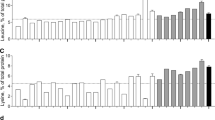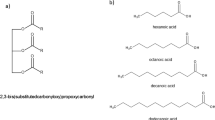Abstract
The objective of this study was to examine whether whole body oxidation rates of dietary linoleic, α-linolenic and oleic acids differ when the acids are provided in identical quantities. Male rats were fed for 10 wk a 15% fat (w/w) diet containing equal amounts of linoleic, α-linolenic and oleic acids (22.7, 23.0 and 23.2% of total fatty acids, respectively). At week 10, after overnight fasting, rats were intragastrically administered 20 μCi of either [1-14C]-labelled linoleic, α-linolenic or oleic acid in a 200-μL bolus of oil containing equal quantities of each fatty acid. The appearance of14CO2 in expired air was then monitored hourly for 12h for each animal. A preliminary study had shown that growth and food consumption patterns in animals consuming the oil containing equal quantities of each of the fatty acids paralleled the patterns of animals that were self-selecting among separate diets, each of which contained one of the component oils. The appearance of14C, expressed as percent dose administered, peaked at 2–3 h post-dose for14C-labelled linoleic (5.28±0.37%/h), α-linolenic (6.92±0.51%/h) and oleic (5.98±0.44%/h) acids. Statistically these values were not significantly different. Cumulative14CO2 excretion rates over 12 h were also similar for linoleic (27.2±0.9%), α-linolenic (26.8±1.2%) and oleic (25.9±1.2%) acids. The results suggest that the rat's capacity to oxidize 18-carbon unsaturated fatty acids is not affected by fatty acid unsaturation when these fatty acids are provided at equal dietary levels.
Similar content being viewed by others
Abbreviations
- FAME:
-
fatty acid methyl esters
- GLC:
-
gas-liquid chromatography
- MUFA:
-
monounsaturated fatty acids
- PUFA:
-
polyunsaturated fatty acids
- SAFA:
-
saturated fatty acids
References
Mercer, S.W., and Trayhurn, P. (1987)J. Nutr. 117 2147–2153.
Shimomura, Y., Tamura, T., and Suzuki, M. (1990)J. Nutr. 120, 1291–1296.
Herzberg, G.R. (1991)Can. J. Phys. Pharmacol. 69, 1637–1647.
Parrish, C.C., Pathy, D.A., Parkes, J.G., and Angel, A. (1991)J. Cell Physiol. 148, 493–502.
Su, W., and Jones, P.J.H. (1993)J. Nutr. 123, 2109–2114.
Leyton, J., Drury, P.J., and Crawford, M.A. (1987)Brit. J. Nutr. 57, 383–393.
Lynn, W.S., and Brown, R.H. (1959)Arch. Biochem. Biophys. 81, 353–362.
Coots, R.H. (1964)J. Lipid Res. 5, 468–472.
Cenedella, J.R., and Allen, A. (1969)Lipids 4, 155–158.
Mead, J.F., Slaton, W.H., and Decker, A.B. (1956)J. Biol. Chem. 218, 401–407.
Jones, P.J.H., Pencharz, P.B., and Clandinin, M.T. (1985)Am. J. Clin. Nutr. 42, 769–777.
Toorop, A.I., Romsos, D.R., and Leveille, G.A. (1979)Proc. Soc. Exp. Biol. Med. 160, 312–316.
Bannon, C.D., Graske, J.D., Har, N.T., Harper, N.L., and O'Rourke, K.L. (1982)J. Chromatogr. 247, 63–69.
Bottino, N.R., Anderson, R.E., and Reiser, R. (1965)J. Am. Oil Chem. Soc. 42, 1124–1129.
Watkins, J.B., Klein, P.D., Schoeller, D.A., Kirschner, B.S., Park, R., and Perman, J.A. (1982)Gastroenterol. 82, 911–917.
Abt, A.F., and Schuching, S.L. (1966)J. Hopkins Med. J. 119, 316–330.
Forsgren, L. (1968)Arkiv. Kemi 30, 355–360.
Dupont, J. (1966)Lipids 1, 415–421.
Dupont, J., and Mathias, M.M. (1969)Lipids 4, 478–483.
Spitzer, J.J., and Gold, M. (1965)Ann. N.Y. Acad. Sci. 131, 235–249.
Nestel, P.J., and Barter, P. (1971)Clin. Sci. 40, 345–350.
Awad, A.B., Bernardis, L.L., and Fink, C.S. (1990)J. Nutr. 120, 1277–1282.
Vahouny, G.V., and Treadwell, C.R. (1959)Am. J. Physiol. 196, 881–883.
Ockner, R.K., Pittman, J.P., and Yager, J.L. (1972)Gastroenterol. 62, 981–992.
Jones, P.J.H., Pencharz, P.B., and Clandinin, M.T. (1985)J. Lab. Clin. Med. 105, 647–652.
McDonald, G.B., Saunders, D.R., Weidman, M., and Fisher, L. (1980)Am. J. Physiol. 239, G141-G150.
Author information
Authors and Affiliations
About this article
Cite this article
Jones, P.J.H. Dietary linoleic, α-linolenic and oleic acids are oxidized at similar rates in rats fed a diet containing these acids in equal proportions. Lipids 29, 491–495 (1994). https://doi.org/10.1007/BF02578246
Received:
Revised:
Accepted:
Published:
Issue Date:
DOI: https://doi.org/10.1007/BF02578246




